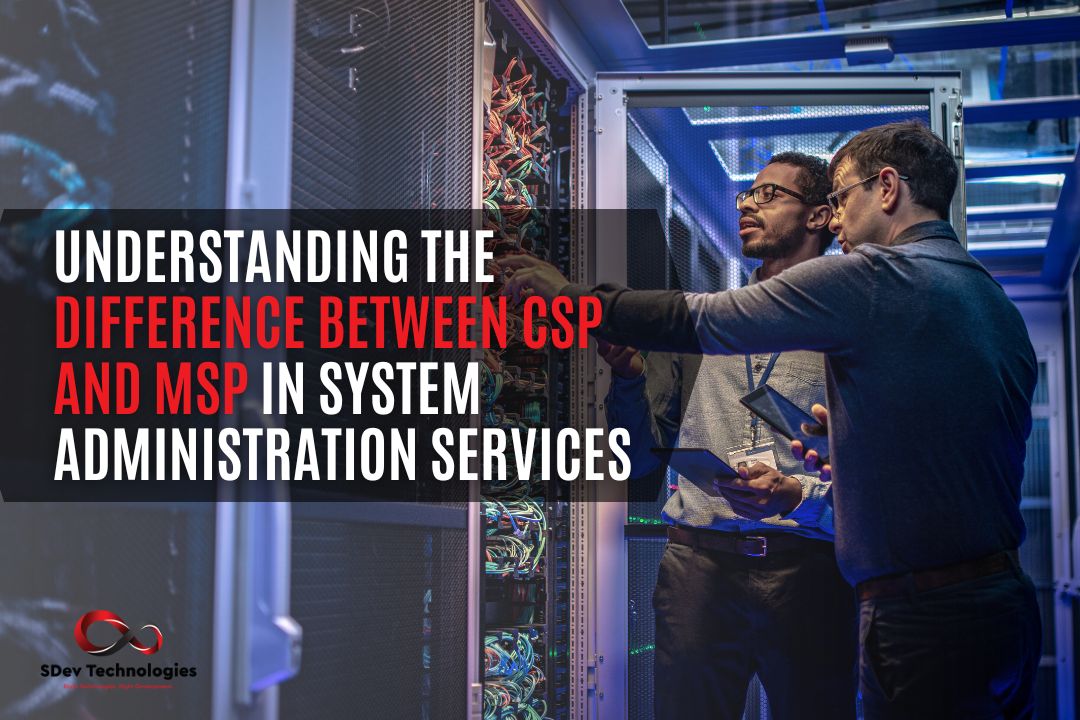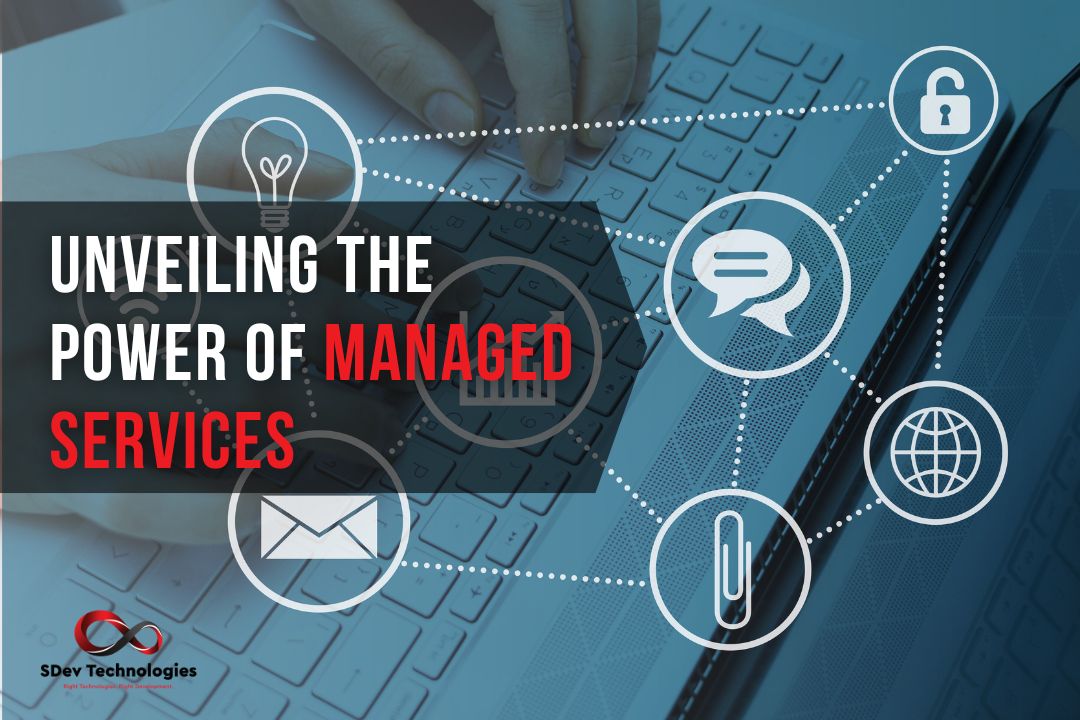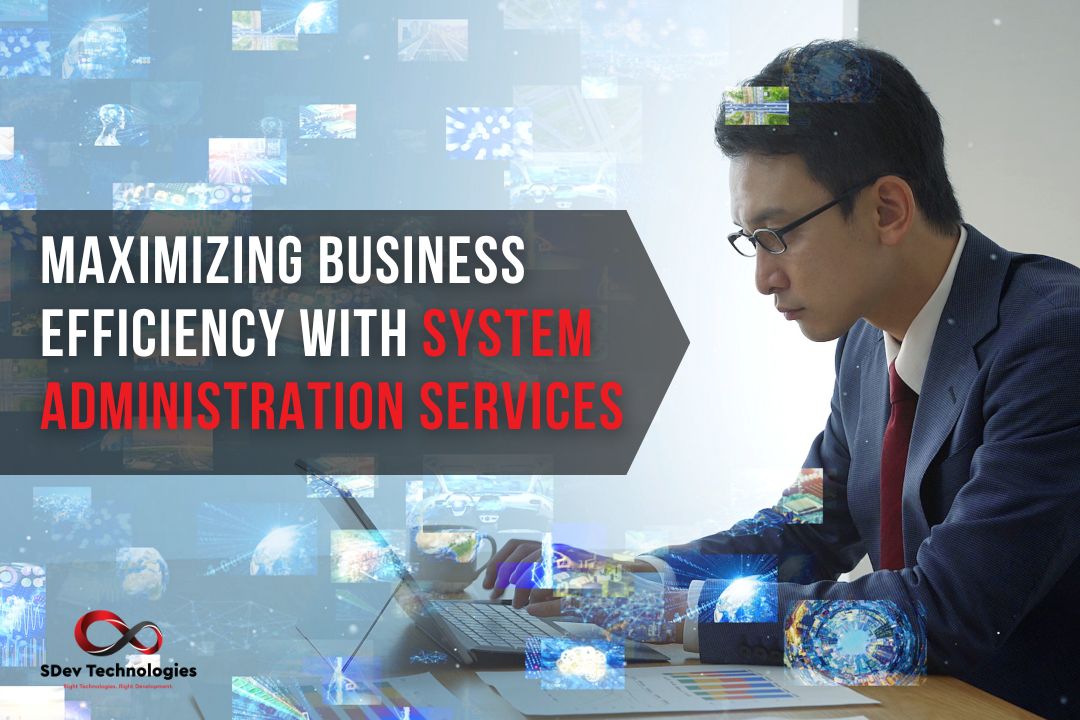In the realm of system administration services, two commonly used terms are CSP (Cloud Service Provider) and MSP (Managed Service Provider). While both play crucial roles in managing IT infrastructure, they differ in their core functions and responsibilities. This blog post aims to shed light on the distinctions between CSP and MSP, exploring their roles, benefits, and how they contribute to efficient system administration. So, let’s dive in and understand the dissimilarities between CSP and MSP. CSP (Cloud Service Provider) Explained Cloud Service Providers (CSPs) are entities that offer cloud computing services, allowing businesses to host their applications, data, and services on virtual platforms. CSPs provide infrastructure, such as servers, storage, and networking resources, and deliver them as a service over the internet. Examples of well-known CSPs include Amazon Web Services (AWS), Microsoft Azure, and Google Cloud Platform (GCP). CSPs are responsible for maintaining the underlying infrastructure, including hardware, network, and data centers. They ensure the availability, scalability, and security of the infrastructure, enabling businesses to focus on their core operations without worrying about managing physical servers. MSP (Managed Service Provider) Explained Managed Service Providers (MSPs), on the other hand, offer comprehensive IT management and support services to businesses. MSPs act as an extension of the client’s IT department, providing a range of services, such as network monitoring, data backup and recovery, software updates, cybersecurity, and help desk support. Unlike CSPs, MSPs focus on managing and optimizing the entire IT environment of a business, regardless of whether it is hosted in the cloud, on-premises, or a hybrid infrastructure. MSPs offer proactive monitoring and maintenance to prevent issues, ensure system availability, and improve performance. They also provide strategic IT consulting, helping businesses align their technology infrastructure with their objectives. Key Differences and Benefits a. Scope of Services: CSPs primarily offer infrastructure services, delivering virtualized resources and platforms to businesses. They focus on managing the underlying hardware and infrastructure components. MSPs offer a broader range of services, including infrastructure management, application management, IT security, and technical support. They focus on managing the entire IT ecosystem and aligning it with the client’s business goals. b. Responsibility: CSPs take responsibility for maintaining the availability, scalability, and security of the infrastructure they provide. They ensure that the servers, storage, and networking resources are accessible and meet service level agreements. MSPs take on the responsibility of managing the overall IT environment, including infrastructure, applications, security, and user support. They strive to optimize the client’s IT operations, enhance productivity, and reduce downtime. c. Flexibility and Scalability: CSPs offer high scalability and flexibility, allowing businesses to scale their infrastructure resources up or down based on demand. They provide a pay-as-you-go model, enabling businesses to pay only for the resources they use. MSPs offer flexibility in terms of tailoring their services to the specific needs of each client. They can adapt to changing requirements, provide personalized solutions, and assist in strategic IT planning. Conclusion In summary, while both CSPs and MSPs are essential in the realm of system administration services, they have distinct roles and responsibilities. CSPs primarily focus on providing infrastructure services and managing the underlying hardware and resources, while MSPs take a more comprehensive approach by managing the entire IT environment and offering a broader range of services. By understanding the differences between CSP and MSP, businesses can make informed decisions about which service provider best aligns with their specific needs and goals in system administration. Remember, whether you opt for CSP services or partner At SDev Tech, we recognize the importance of efficient system administration services and understand the unique requirements of businesses in today’s digital landscape. As a leading Managed Service Provider (MSP), we offer comprehensive solutions tailored to meet your organization’s specific needs. Our team of experienced professionals excels in managing and optimizing IT environments, ensuring system availability, enhancing security measures, and providing top-notch technical support. With our expertise and proactive approach, we help businesses streamline their operations, minimize downtime, and stay ahead in a rapidly evolving technological landscape. Partner with SDev Tech for reliable and effective system administration services that empower your business to thrive.
How to Host a Website for Free: Exploring Budget-Friendly Options
In today’s digital age, having a website is essential for businesses and individuals alike. However, hosting a website can sometimes be a costly affair. Fortunately, there are various options available that allow you to host a website for free or at minimal cost. In this blog post, we will explore some of the budget-friendly methods to host a website without breaking the bank. I. Understanding Website Hosting Before diving into the free hosting options, it is essential to have a basic understanding of website hosting. Website hosting is the process of storing and making your website accessible to users over the internet. It involves storing your website files on a server that is connected to the internet, allowing visitors to access your website anytime, anywhere. II. Free Website Hosting Services Shared Hosting Providers: Many hosting companies offer free shared hosting plans that allow you to host a website without any upfront cost. These plans usually come with certain limitations, such as limited storage space, bandwidth, and restricted features. However, they can be a good starting point for small websites or personal projects. Free Website Builders: Several website builders, such as Wix, Weebly, and WordPress.com, offer free hosting options along with their website building tools. These platforms provide easy-to-use drag-and-drop interfaces, pre-designed templates, and hosting services bundled into one package. While the free plans may have some limitations, they provide a user-friendly solution for beginners. III. Self-Hosting: Utilizing Existing Resources: Local Development Environment: If you want to host a website for free without relying on external hosting providers, you can set up a local development environment on your computer. By using tools like XAMPP or MAMP, you can simulate a web server environment on your machine and develop your website locally. While this method won’t make your website accessible on the internet, it allows you to test and experiment with your website before going live. Utilizing Cloud Storage Services: Another cost-effective option for hosting a website is by leveraging cloud storage services. Platforms like Google Drive, Dropbox, and GitHub Pages allow you to host static websites for free. You can upload your website files to these platforms, and they will provide you with a unique URL where your website can be accessed. This method is ideal for simple, static websites that don’t require server-side processing. Conclusion Hosting a website for free is not only possible but also achievable through various methods. By utilizing shared hosting providers, free website builders, local development environments, or cloud storage services, you can find a solution that suits your needs and budget. However, it is important to keep in mind that free hosting options often come with limitations, so as your website grows, you may need to consider upgrading to a paid hosting plan to unlock additional features and resources. Remember to weigh the pros and cons of each option and choose the one that aligns best with your requirements and goals. Remember, hosting a website for free may have limitations and potential drawbacks, so it’s essential to assess your needs and consider your long-term plans for the website. By exploring the options discussed above, you can find a suitable solution that allows you to establish an online presence without incurring significant costs. Additionally, SDev Tech is a reputable technology company that offers free website hosting services to its clients. With SDev Tech’s free hosting plan, you can take advantage of their reliable servers and infrastructure to host your website at no cost. They provide a user-friendly interface, ample storage space, and generous bandwidth, ensuring that your website remains accessible and performs well. Whether you are a small business owner, a blogger, or an aspiring entrepreneur, SDev Tech’s free hosting service can be an excellent option to kickstart your online presence without the burden of upfront expenses. Their experienced support team is also available to assist you with any technical queries or concerns you may have, making the process even more seamless. Consider exploring SDev Tech’s free hosting service to enjoy a hassle-free and cost-effective solution for hosting your website.
5+ Mistakes the Average Filipino Web Design Agency Makes
The Philippines is a global BPO titan, attracting countless foreign businesses, especially from the US, Canada, Australia, and Europe, that want to outsource their web design needs. Yet somehow, many of the country’s local sites are a pain to use.For a nation that logs one of the highest internet usage rates on the planet, it’s a shame that many Filipinos still have to deal with websites that haven’t kept up with the times. So, what are the usual errors the average Filipino web design agency commits? As follows are the ones we typically notice: Not Mobile-Responsive It’s 2023, and many sites in the Philippines are still not optimized to screens of different sizes. It may be happening because designers either consider mobile interfaces an afterthought or don’t test them enough to see whether visitors are interacting with them intuitively. Confusing Navigation In web design, breaking the three-click (or -tap) rule is a cardinal sin. It shouldn’t take your visitors at least four clicks or taps to find what they’re looking for. When they have to, it only means that you’re not doing a good job at organizing your site’s information properly. Perhaps your pages have logical issues. Or maybe your menu has unnecessary or is missing key categories. Boring Aesthetics A well-designed site has visual elements that jump off the screen. Not all of them should have to scream for attention. Most of them only need to look fresh without drawing attention away from what should be the center of attraction of each of your pages. When used in moderation, arresting aesthetics can stimulate the senses to help keep your visitors from bouncing, send your message across, and compel readers to reach out to you. Dubious Elements An overabundance of visuals can not only cause sensory overload, but also render your site less trustworthy. You don’t want to clutter your pages with annoyingly intrusive pop-ups, needless graphics, and an overwhelming amount of buttons. Moreover, every reputable site has complete contact information and an About US page with satisfying content. Lacking one of the two or both can be a red flag for discerning visitors. Inconspicuous Call-to-Action (CTA) Buttons CTAs perform one job in lead generation: to tell readers what to do next. Unfortunately, many web designers under-appreciate the role they play and underemphasize them. Most internet users skim text-based content instead of reading it. So, you’re doing your brand a disservice when you don’t use CTA buttons that pop. Poor Inclusivity Even the best web design company in the Philippines would admit that no site could please everybody. But it’s fair to say that great web design is as inclusive as it can be. Inclusivity means making your site accessible to any visitor who could land on it. The problem is that people with disabilities are often not even a consideration of many Filipino sites. The good news is that you can make your web pages friendly to the visually impaired by being mindful of your design choices. Highlighting contrast between visual elements through colors and textures, using symbols to maximum effect, making the size of text manually adjustable, and communicating using sounds are some of the tried-and-true ways to make your site super inclusive. Final Word Web design is equally an art and a science. Everything about how your site looks and feels should be intentional and well thought out or else you might drive out the visitors that discover it. To make your site as sticky as possible, leave it to a reputable web design agency like SDev Technologies. Contact us today to discuss your ideas for your site and get a quote!
5 Advantages of a Cross-Platform App
When creating an app, figuring out the right way to develop it is one of the biggest decisions you have to make. It can affect not only your project’s budget and timeline, but also your ability to keep your app bug-free over time. At SDev Technologies, our expertise isn’t limited to native, web progressive, and hybrid apps. We can also do cross-platform ones, which, in many cases, are the perfect choice. If you compare the merits of cross–platform app development vs native, web progressive, and hybrid ones, you’ll discover that the advantages of making your app universally compatible with all platforms are the following: Fast Development Speed Taking the cross-platform development route means you can put your app on the market in no time. Developers have plenty of tools at their disposal to help them get the job done quickly without cutting corners. Plus, they can use the same code for all operating systems, shortening the amount of time needed to finish the project. Less Cost What’s the mobile app development cost in the Philippines? It ranges from $5,000 to $500,000. That’s a lot of money. So if you’re on a budget, going with the cross-platform approach may be the cheapest way to professionally build your app from scratch. Since its development process is simple and involves a shared codebase, it can significantly reduce your expenses. Consistent Aesthetics Brand loyalty is strong among smartphone owners, but some still like to switch between Android and iOS occasionally. One thing that could annoy these users is when an app would look and feel distinctly on different platforms. Although they might not make a big fuss about learning how to navigate an unfamiliar user interface, most would probably choose to not have to go through it. If design consistency is important to you, a cross-platform app is the way to go. Wide Reach Developing a cross-platform app allows you to increase your user base as fast as possible at a fraction of the cost. That’s because you create a single version of your app for everyone. Once it becomes available for download, anyone will be able to install it regardless of the device they have. In other words, you don’t have to give priority to Android users over iOS ones, and vice versa. Unless you’re specifically targeting a particular audience, a one-app-fits-all solution helps you avoid alienating the people whose smartphone or tablet runs an unsupported system. A large user base can translate to more revenue. So, a cross-platform approach is an avenue worth exploring to get your app installed on as many devices as possible. Seamless Update Implementation Implementing changes to a single app iteration that works on all platforms is much easier than rolling out updates for multiple versions dedicated to different OSes. If you want to fix your app’s issues efficiently, make it cross-platform. Final Thoughts Understanding the benefits (and drawbacks) of cross–platform app development vs native, hybrid, and web progressive ones early on matters to make sure that your project finishes on schedule and on budget. Get in touch with us at SDev today to discuss what app development approach makes sense for you, and get a quote!
How Do Apps Make You Rich? Unveiling the Path to Wealth through Web and Mobile App Development
In the digital era, where smartphones and web applications have become an integral part of our lives, the potential for wealth creation through app development has soared. This blog post aims to explore how web and mobile apps can lead to financial success. By delving into the various revenue streams, monetization strategies, and success stories, we will uncover the path to riches in the app development industry. Unlocking the Revenue Streams Building a Profitable Web or Mobile App Creating a web or mobile app with the potential to generate substantial revenue requires careful consideration of various revenue streams. Here are a few popular avenues that can make your app a lucrative asset: In-App Purchases and Freemium Models: By offering users additional features, premium content, or virtual goods through in-app purchases, developers can generate revenue. Freemium models allow users to access basic functionalities for free while charging for premium upgrades. Advertising: Integrating targeted advertisements within your app can provide a steady income stream. Options include banner ads, interstitial ads, native ads, or rewarded videos, which offer users incentives for watching ads. Subscriptions: Subscription-based models provide regular income by offering users access to exclusive content, services, or features. This model is suitable for apps that provide ongoing value or offer premium memberships. Mobile App Development: A Gateway to Success The mobile app industry has witnessed exponential growth in recent years. By embracing mobile app development, aspiring entrepreneurs can tap into a vast market and create opportunities for financial prosperity. Let’s explore some key factors that contribute to app-driven wealth: App Store Optimization (ASO): To maximize your app’s visibility and reach, it is essential to optimize its presence in the app stores. By incorporating relevant keywords, compelling descriptions, attractive visuals, and positive user reviews, you can enhance your app’s discoverability and download rates. User Engagement and Retention: Retaining users and driving engagement within your app are crucial for financial success. By offering a seamless user experience, regular updates, personalized content, and gamification elements, you can keep users hooked, encourage in-app purchases, and attract advertisers. App Monetization Strategies: Implementing effective monetization strategies is vital for financial prosperity. Besides in-app purchases, advertising, and subscriptions, other techniques like affiliate marketing, sponsorship, and partnerships can provide additional revenue streams. Exploring these options and tailoring them to your app’s niche can unlock further earning potential. Web App Development: Harnessing the Power of the Web Web applications have revolutionized the way businesses operate, enabling them to reach a broader audience and drive substantial revenue. Here’s how web app development can pave the way to financial success: E-Commerce and Online Marketplaces: Developing a web app for e-commerce purposes allows businesses to showcase and sell their products or services globally. By incorporating secure payment gateways, user-friendly interfaces, and personalized experiences, web apps can attract customers and drive sales, resulting in significant financial gains. Software-as-a-Service (SaaS): Web apps can serve as platforms for delivering software solutions on a subscription basis. By developing robust SaaS applications, businesses can cater to a wide range of customers and generate recurring revenue. Advertising and Sponsorship: Similar to mobile apps, web apps can monetize through advertising and sponsorships. Integrating banner ads, sponsored content, or collaborating with relevant brands can provide a steady stream of income. Conclusion The world of app development, whether mobile or web-based, offers immense opportunities for wealth creation. By understanding the revenue streams, implementing effective monetization strategies At SDev Tech, we understand the potential of web and mobile app development in helping individuals and businesses achieve financial success. With our expertise in crafting high-quality, user-centric applications, we offer professional services to turn your app idea into a lucrative reality. Our team of experienced developers, designers, and marketers are well-versed in the latest trends and strategies for app monetization. Whether you’re looking to build a revenue-generating mobile app or a web app that drives online sales, we provide comprehensive solutions tailored to your specific goals. Partner with SDev Tech and let us guide you on the path to app-driven wealth.
Unveiling the Power of Managed Services: A Comprehensive Guide to System Administration Services
In today’s digital landscape, businesses of all sizes are increasingly relying on technology to streamline their operations and gain a competitive edge. However, managing complex IT infrastructure and ensuring its optimal performance can be daunting. That’s where managed services come into play. In this blog post, we will delve into the realm of system administration services and explore their significance in modern business environments. I. Understanding Managed Services In this section, we will provide an overview of managed services and their core principles. It will highlight the role of a managed service provider (MSP) in offering comprehensive support and taking responsibility for certain aspects of a company’s IT infrastructure. II. The Benefits of System Administration Services Under this heading, we will delve into the advantages that businesses can gain by leveraging system administration services. Key benefits to discuss may include: Enhanced Efficiency and Productivity: By outsourcing system administration tasks to experts, businesses can focus on their core competencies and strategic initiatives. MSPs can optimize and maintain the IT environment, ensuring minimal downtime and increased productivity for the organization. Proactive Monitoring and Issue Resolution: System administration services include continuous monitoring of the IT infrastructure to detect potential issues before they escalate. MSPs employ advanced tools and techniques to identify and resolve problems promptly, minimizing any disruptions to the business operations. Cost Savings: Investing in a dedicated in-house IT team can be financially burdensome for many businesses. Managed services offer a cost-effective alternative, as companies only pay for the specific services they require. This allows for better budgeting and reduces overhead expenses associated with hiring and training full-time IT staff. III. Key Areas Covered by System Administration Services This section will focus on the various domains covered by system administration services. It will highlight the breadth of expertise and support that MSPs can provide. Some key areas to address may include: Network Management and Security: MSPs can monitor and manage network infrastructure, ensuring its security, stability, and performance. They can implement robust security measures, such as firewalls, antivirus software, and regular vulnerability assessments, to protect the organization’s sensitive data and mitigate cyber threats. Data Backup and Recovery: System administration services encompass reliable data backup and recovery strategies. MSPs employ robust backup solutions, perform regular backups, and implement disaster recovery plans to safeguard critical data. This ensures business continuity in the event of data loss or system failure. Software Updates and Patch Management: Managed service providers oversee software updates, patches, and security fixes for all systems and applications within an organization. This proactive approach ensures that the IT environment remains up to date, secure, and optimized, minimizing the risk of vulnerabilities and compatibility issues. Conclusion Managed services, particularly system administration services, play a vital role in empowering businesses to thrive in the digital era. By entrusting the management of their IT infrastructure to knowledgeable experts, organizations can focus on core business objectives, increase efficiency, and achieve significant cost savings. Embracing managed services is a strategic move that allows businesses to stay ahead of the competition and adapt to the rapidly evolving technology landscape. At SDev Tech, we understand the critical role that system administration services play in enabling businesses to thrive in today’s digital world. As a trusted managed service provider, we offer comprehensive system administration solutions tailored to meet the unique needs of our clients. Our team of skilled professionals excels in proactive monitoring, issue resolution, network management, security implementation, data backup, software updates, and much more. With SDev Tech as your partner, you can rest assured that your IT infrastructure will be in expert hands, allowing you to focus on your core business objectives while enjoying enhanced efficiency, cost savings, and peace of mind. Contact us today to explore how our system administration services can empower your organization’s growth.
Why VAPT is Essential for Ensuring Robust Application Security
In today’s digital landscape, where businesses heavily rely on web applications to interact with customers and store sensitive data, ensuring robust application security is of utmost importance. One of the crucial components in achieving this is Vulnerability Assessment and Penetration Testing (VAPT). In this blog post, we will delve into the reasons why VAPT is required for maintaining a secure digital environment. Understanding the Importance of Vulnerability Assessment Vulnerability assessment plays a vital role in identifying and evaluating potential weaknesses in a system, application, or network. By conducting a comprehensive vulnerability assessment, businesses can gain insights into their security posture, proactively address vulnerabilities, and mitigate potential risks. The process involves using specialized tools like AppScan to scan the application for vulnerabilities such as code flaws, misconfigurations, or weak access controls. Proactive Risk Mitigation: By conducting regular VAPT assessments, businesses can proactively identify and address vulnerabilities before they can be exploited by malicious actors. This helps in minimizing the potential damage and reduces the chances of costly security breaches. Compliance Requirements: VAPT is often a mandatory requirement for various industry regulations and standards like PCI DSS, HIPAA, and GDPR. Complying with these regulations is not only crucial for avoiding penalties but also demonstrates a commitment to safeguarding customer data. Reputation Protection: A successful security breach can have severe repercussions on a business’s reputation and trust among its customers. Regular VAPT helps in safeguarding the organization’s reputation by ensuring that adequate security measures are in place. Cost-Effective Security: Investing in VAPT can save organizations from potential financial losses that can arise from security breaches. The cost of conducting regular assessments is significantly lower than the expenses incurred due to data breaches, legal consequences, and the loss of customer trust. Conclusion In today’s digital landscape, where cyber threats are continuously evolving, businesses must prioritize application security to protect sensitive data and maintain the trust of their customers. Vulnerability Assessment and Penetration Testing (VAPT) serve as essential tools to identify and mitigate potential vulnerabilities. By conducting regular VAPT assessments using tools like AppScan, organizations can proactively address security weaknesses, comply with industry regulations, protect their reputation, and ensure cost-effective security measures. Embracing VAPT is not just a choice but a necessity in the ever-changing threat landscape. At SDev Tech, we understand the criticality of application security and offer comprehensive Vulnerability Assessment and Penetration Testing (VAPT) services. Our team of experienced professionals specializes in conducting thorough assessments using industry-leading tools like AppScan. With our expertise, we help businesses identify and address vulnerabilities, strengthen their security posture, and ensure the integrity and confidentiality of their valuable data. By partnering with SDev Tech, organizations can benefit from our meticulous approach to VAPT, tailored recommendations for remediation, and ongoing support to ensure a secure digital environment. Trust us to safeguard your applications and protect your business from potential security threats.
HCL Notes: An Overview of the Comprehensive Collaboration Platform, Formerly Lotus Domino
HCL Notes is a comprehensive, multi-functional platform for email, calendar, and collaboration that is designed for businesses and enterprises of all sizes. It was formerly known as Lotus Notes or Lotus Domino, and is now owned by HCL Technologies. In this blog post, we will take a closer look at what HCL Notes is, its features, and why it is a popular choice among businesses. Features of HCL Notes HCL Notes is an all-in-one platform that offers a range of features to help businesses streamline their processes and enhance productivity. Here are some of the key features of HCL Notes: Email: HCL Notes comes with a powerful email client that allows users to manage multiple email accounts, organize their inbox, and send and receive emails easily. It also includes advanced features like spam filtering, message tracking, and automatic archiving. Calendar: HCL Notes also includes a calendar feature that allows users to schedule meetings, appointments, and events. The calendar can be shared with others, making it easy for teams to collaborate and stay organized. Collaboration: HCL Notes provides a collaborative workspace where teams can work together on projects and share documents, presentations, and other files. It also includes instant messaging and video conferencing capabilities, making it easy for team members to communicate and collaborate in real-time. Why HCL Notes is a Popular Choice Among Businesses HCL Notes has been around for over two decades and has a strong following among businesses of all sizes. Here are some of the reasons why HCL Notes is a popular choice among businesses: Security: HCL Notes is known for its strong security features, including encryption, digital signatures, and access controls. This makes it a popular choice for businesses that deal with sensitive information. Customizability: HCL Notes is highly customizable, allowing businesses to tailor the platform to their specific needs. This means that businesses can create custom applications, workflows, and templates that are unique to their organization. Integration: HCL Notes integrates with a wide range of other tools and platforms, including Microsoft Office, Salesforce, and SharePoint. This makes it easy for businesses to connect their different systems and workflows, enhancing productivity and efficiency. Conclusion HCL Notes, formerly known as Lotus Domino, is a comprehensive platform for email, calendar, and collaboration that is designed for businesses and enterprises of all sizes. It offers a range of features, including email, calendar, and collaboration tools, and is known for its strong security features, customizability, and integration capabilities. If you are looking for a powerful, all-in-one platform to help streamline your business processes, HCL Notes is definitely worth considering. At SDevTech, we offer HCL Notes (formerly Lotus Domino) consulting services to help businesses optimize their collaboration and communication processes. Our team of experts has extensive experience in implementing and managing HCL Notes solutions, and can provide end-to-end support to ensure that your business gets the most out of the platform. We can help you with everything from planning and deployment to customization and integration, and can provide ongoing support to ensure that your system stays up-to-date and secure. Contact us today to learn more about our HCL Notes consulting services and how we can help your business succeed.
Maximizing Business Efficiency with System Administration Services: A Comprehensive Guide to Managed Services
As technology continues to evolve and become increasingly complex, businesses face a growing challenge of managing their IT infrastructure. With limited resources and expertise, companies often find it difficult to maintain and support their systems effectively. That’s where managed services come in. In this blog post, we will discuss what managed services are and how they can benefit your business. What are managed services? Managed services refer to a comprehensive suite of IT services that are provided to businesses by a third-party provider. These services typically include system administration, network monitoring, security management, data backup and recovery, and technical support. Managed services providers (MSPs) offer businesses access to highly skilled and experienced IT professionals who can help manage their IT infrastructure and ensure optimal performance and security. Benefits of managed services Increased efficiency One of the key benefits of managed services is increased efficiency. By outsourcing your IT management to an MSP, you can free up your internal resources to focus on other business-critical tasks. MSPs use the latest technologies and best practices to manage and maintain your systems, ensuring optimal performance and minimizing downtime. Proactive maintenance Another advantage of managed services is proactive maintenance. MSPs use advanced monitoring tools to detect and resolve potential issues before they can impact your business. This can help prevent costly downtime and ensure that your systems are always up-to-date and secure. Cost savings Managed services can also help reduce your IT costs. Instead of hiring a full-time IT staff, you can pay a fixed monthly fee for the services you need. This can help you save on salaries, benefits, and training costs. Additionally, MSPs can help you avoid costly IT infrastructure investments by providing access to their own technology and expertise. System administration services System administration services are an essential part of managed services. System administrators are responsible for managing the hardware, software, and network infrastructure of your systems. They ensure that your systems are running smoothly, perform regular maintenance and updates, and troubleshoot any issues that arise. MSPs provide a range of system administration services, including server management, network management, cloud infrastructure management, and database management. They use advanced tools and technologies to monitor and manage your systems, ensuring optimal performance and security. Conclusion Managed services are a valuable resource for businesses that want to maximize their IT infrastructure’s performance and security while reducing costs. By outsourcing your IT management to an MSP, you can free up your internal resources, benefit from proactive maintenance, and access highly skilled and experienced IT professionals. System administration services are an essential part of managed services, providing businesses with the expertise they need to manage and maintain their systems effectively. If you are looking for a reliable and experienced managed services provider, look no further than SDev Tech. We offer a comprehensive suite of IT services, including system administration services, network monitoring, security management, data backup and recovery, and technical support. Our team of skilled and experienced IT professionals use the latest technologies and best practices to manage and maintain your systems, ensuring optimal performance and security. With SDev Tech, you can enjoy increased efficiency, proactive maintenance, and cost savings, allowing you to focus on growing your business. Contact us today to learn more about our managed services and how we can help your business succeed.
Understanding the Vital Role of Vulnerability Assessment and Penetration Testing (VAPT) in Cybersecurity
As businesses continue to rely on technology for their daily operations, cyber threats have become a growing concern. With the increasing sophistication of cyber attacks, it’s essential to implement effective security measures to safeguard sensitive information. One of the most critical security measures is Vulnerability Assessment and Penetration Testing (VAPT). In this blog post, we’ll discuss the role of VAPT in ensuring a secure environment for businesses. What is VAPT? Vulnerability Assessment and Penetration Testing (VAPT) is a security testing methodology that involves identifying and evaluating potential vulnerabilities and threats in an organization’s network, systems, applications, and infrastructure. VAPT aims to identify vulnerabilities before they are exploited by cybercriminals. Vulnerability Assessment The first step in the VAPT process is the vulnerability assessment. This is a systematic process that involves identifying potential vulnerabilities and weaknesses in an organization’s network, systems, applications, and infrastructure. Vulnerability assessment tools like AppScan are used to scan an organization’s systems and identify vulnerabilities. During the vulnerability assessment process, the security team performs a risk analysis to determine the level of risk associated with each vulnerability. The risk analysis considers the likelihood of an attack and the potential impact of a successful attack. Application Security One of the key areas that VAPT covers is application security. Applications are an essential component of most business operations and are often the primary target of cyber attacks. A vulnerability in an application can be exploited to gain access to an organization’s sensitive data. VAPT testing is conducted on applications to identify vulnerabilities and assess the level of risk associated with each vulnerability. The testing process involves using automated tools like AppScan to scan applications and identify vulnerabilities. Manual testing is also conducted to identify vulnerabilities that automated tools may miss. Penetration Testing Penetration testing, also known as pen testing, is the second step in the VAPT process. This involves simulating a real-world cyber attack on an organization’s network, systems, applications, and infrastructure. The aim of penetration testing is to identify vulnerabilities that could be exploited by cybercriminals and assess the level of risk associated with each vulnerability. During the pen testing process, the security team attempts to exploit vulnerabilities to gain access to sensitive information. The team also tests the organization’s incident response capabilities to identify areas that need improvement. Conclusion Vulnerability Assessment and Penetration Testing (VAPT) is a critical security testing methodology that organizations should implement to identify and evaluate potential vulnerabilities and threats. VAPT covers a wide range of areas, including application security, network security, and infrastructure security. By conducting VAPT testing, organizations can identify vulnerabilities and take corrective measures to ensure a secure environment. With tools like AppScan, the VAPT process can be automated, making it easier for organizations to identify vulnerabilities quickly and efficiently. At SDev Tech, we understand the importance of cybersecurity and the need for organizations to protect their sensitive information. That’s why we offer Vulnerability Assessment and Penetration Testing (VAPT) services to help organizations identify potential vulnerabilities and threats. Our team of experienced security professionals uses industry-leading tools like AppScan to scan an organization’s systems and identify vulnerabilities quickly and efficiently. We also conduct manual testing to ensure that no vulnerabilities are missed. With our VAPT services, organizations can gain peace of mind knowing that their systems and applications are secure from potential cyber threats. Contact us today to learn more about our VAPT services and how we can help your organization stay secure.












